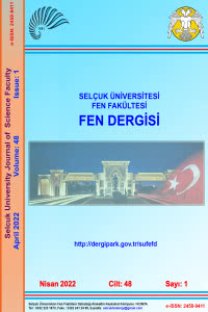EXTENDED KALMAN FILTER DESIGN FOR RAILWAY TRACTION MOTOR
Demiryolu Cer Motorları için Genişletilmiş Kalman Filtresi Tasarımı
___
- longe, F., D'ippolito, F., 2010, “Extended Kalman Filter for Sensorless Control of Induction Motors”, First Symposium on Sensorless Control for Electrical Drives, Padova, Italy, 9-10 July 2010.
- Alsofyani, I. M., Idris, N., Sutikno, T., Alamri, Y. A., 2012, “An optimized Extended Kalman Filter for Speed Sensorless Direct Troque Control of An İnduction Motor”, IEEE International Conference on Power and Energy, Kota Kinabalu, Malaysia, 2-5 December 2012.
- Barut, M., Bogosyan, O., Gokasan, M., 2002, “EKF Based Estimation for Direct Vector Control of Induction Motors”, IEEE 28th Annual Conference of the Industrial Electronics Society, Sevilla, Spain, 5-8 November 2002.
- Barut, M., Bogosyan, S., Gokasan, M., “EKF Based Sensorless Direct Torque Control of IMs in The Low Speed Range”, Proceedings of the IEEE International Symposium on Industrial Electronics, 2005, ISIE 2005, Dubrovnik, Croatia, 20-23 June 2005.
- Barut, M., Bogosyan, S., Gokasan, M., 2007, “Speed-Sensorless Estimation for Induction Motors Using Extended Kalman Filters”, IEEE Transactions on Industrial Electronics, Vol. 54(1), pp. 272-280.
- Barut, M., Gokasan, M., Bogosyan, O., 2003, “An extended Kalman Filter Based Sensorless Direct Vector Control of Induction Motors”, IECON'03. 29th Annual Conference of the IEEE Industrial Electronics Society (IEEE Cat. No.03CH37468), Roanoke, VA, USA, 2-6 November 2003.
- Bogosyan, S., Barut, M., Gokasan, M., 2007, “Braided Extended Kalman Filters for Sensorless Estimation In İnduction Motors at High-Low/Zero Speed”, IET Control Theory & Application, Vol. 1(4), pp. 987-998.
- Cai, L., Zhang, Y., Zhang, Z., Liu, C., Lu, Z., 2003, “Application of Genetic Algorithms in EKF for Speed Estimation of an Inducion Motor”, Proc. on IEEE Power Electronics Specialist Conference, Acapulco, Mexico, Vol. 1, pp. 345-349, 15-19 June 2003.
- Charles, G., Goodall, R., 2006, “Low Adhesion Estimation”, IET International Conference on Railway Condition Monitoring, Birmingham, UK 29-30 Nov. 2006
- Gaspar, P., Szabo, Z., Bokor, J., 2006, “Observer Based Estimation of The Wheel-Rail Friction Coefficient”, IEEE Conference on Computer Aided Control System Design. Munich, Germany 4-6 Oct. 2006
- Hussain, I., Mei, T. X., Ritchings, R. T., 2013, “Estimation of Wheel–Rail Contact Conditions and Adhesion Using The Multiple Model Approach”, Vehicle System Dynamics, Vol. 51(1), pp. 32-53.
- Iwnicki, S., 2003, “Simulation of Wheel-Rail Contact Forces”, Fatigue Fracture of Engineering Materials and Structures, Vol. 26(10), pp. 887-900.
- Kalker, J., 1968, “On The Rolling Contact of Two Elastic Bodies in The Presence of Dry Friction”, Wear, Vol. 11(4), pp. 303.
- Kawamura, A., Takeuchi, K., Furuya, T., Cao, M., Takaoka, Y., Yoshimoto, K., 2003, “Measurement of Tractive Force and the New Maximum Tractive Force Control by the Newly Developed Tractive Force Measurement Equipment”, IEEJ Transactions on Industry Applications, Vol. 123(8), pp. 885-893.
- Matsumoto, Y., Eguchi, N., Kawamura, A., 2001, “Novel Re-Adhesion Control for Train Traction System of The "Shinkansen" with The Estimation of Wheel-to-Rail Adhesive Force”, IECON'01, 27th Annual Conference of the IEEE Industrial Electronics Society (Cat. No.37243), Denver, CO, USA, Vol. 2, pp. 1207-1212 29 Nov.-2 Dec. 2001
- Mei, T., Hussain, I., 2010, “Detection of Wheel-Rail Conditions for Improved Traction Control”, IET Conference on Railway Traction Systems, Birmingham, UK 13-15 April 2010
- Polach, O., 1999, “A Fast Wheel-Rail Forces Calculation Computer”, Veh. Syst. Dyn. Suppl, 1999, Vol. 33, pp. 728–739.
- Radionov, I. A., Mushenko, A. S., 2015, “The method of estimation of adhesion at “wheel-railway” contact point”, 2015 International Siberian Conference on Control and Communications (SIBCON), Omsk, Russia, 21-23 May 2015.
- Rizzo, R., Iannuzzi, D., 2002, “Indirect Friction Force Identification for Application in Traction Electric Drives”, Mathematics and Computers in Simulation, Vol. 60(3-5), pp.379-387.
- Shi, K., Chan, T., Wong, Y., Ho, S., 2002, Speed Estimation of An İnduction Motor Drive Using an Optimized Extended Kalman Filter”, IEEE Transactions on Industrial Electronics, Vol. 49(1), pp.124-133.
- Singh, K., Singh, M., 2013, “Design of Kalman Filter for Induction Motor Drive” Students Conference on Engineering and Systems (SCES), Allahabad, India, 12-14 April 2013.
- Wang, S., Xiao, J., Huang, J., Sheng, H., 2016, “Locomotive Wheel Slip Detection Based on Multi-Rate State İdentification of Motor Load Torque”, Journal of the Franklin Institute, 2016, Vol. 353(2), pp. 521-540.
- Ward, C. P., Goodall, R. M., Dixon, R., 2011, “Contact Force Estimation in the Railway Vehicle WheelRail Interface”, IFAC Proceedings Volumes, Vol. 44(1), pp. 4398-4403.
- Ward, C., Goodall, R., Dixon, R., Charles, G., 2012, “Detection of Low Adhesion in The Railway Vehicle Wheel/Rail İnterface: Assessment of Multi-Bodied Simulation Data, Proceedings of 2012
- UKACC International Conference on Control, Cardiff, UK, 3-5 September 2012.
- Zhao, Y., Liang, B., 2013, “Re-adhesion Control for A Railway Single Wheelset Test Rig Based on The Behaviour of The Traction Motor”, Vehicle System Dynamics, Vol. 51(8), pp. 1173-1185.
- Zhao, Y., Liang, B., Iwnicki, S., 2012, “Estimation of the Friction Coefficient Between Wheel and Rail Surface Using Traction Motor Behaviour”, Journal of Physics: Conference Series, 2012, Vol. 364, 012004.
- Zhao, Y., Liang, B., Iwnicki, S., 2014, “Friction Coefficient Estimation Using an Unscented Kalman Filter”, Vehicle System Dynamics, Vol. 52(Sup1), pp. 220-234.
- ISSN: 2147-9364
- Yayın Aralığı: Yılda 2 Sayı
- Başlangıç: 2013
- Yayıncı: Selçuk Üniversitesi Mühendislik Fakültesi
FREKANS ANALİZİNDE ALTERNATİF BİR PARAMETRE TAHMİN METODU
ERİMİŞ TUZ İÇİNDE ELEKTROKİMYASAL İNDİRGENME YÖNTEMİYLE SİLİSYUM ÜRETİMİ
Metehan ERDOĞAN, Emre ERGÜL, İshak KARAKAYA
A MONOGENIC LOCAL GABOR BINARY PATTERN FOR FACIAL EXPRESSION RECOGNITION
Halil İbrahim SOLAK, Ayşegül ALAYBEYOĞLU
Bir Çimento Fabrikası İnşaatı Sırasında Gözlemlenen Zemin Çökmeleri ve Sonuçları
KÜPRİK OKSİT/SİLİSYUM HETEROEKLEMLİ NANODİYOTLARIN FOTOVOLTAİK ÖZELLİKLERİ
EXTENDED KALMAN FILTER DESIGN FOR RAILWAY TRACTION MOTOR
BİYOKÖMÜR: ÜRETİMİ ve KULLANIM ALANLARI
Güneş Enerjisi Destekli Hidrojen Üretimi: Teorik Bir Vaka Çalışması
ALİ ATEŞ, Sacit Zendehdel SHEKARDASHT, EYÜB CANLI
SANTRİFÜJ BİR KALP DESTEK POMPASI PROTOTİPİNİN SAYISAL VE DENEYSEL OLARAK İNCELENMESİ
